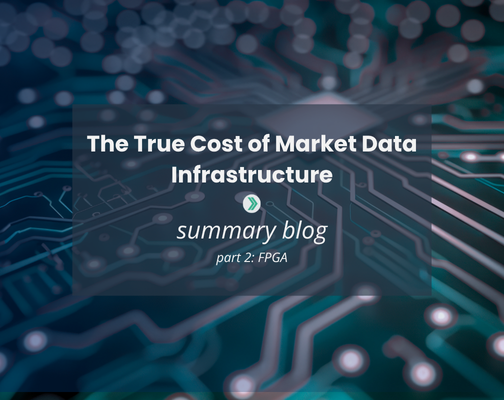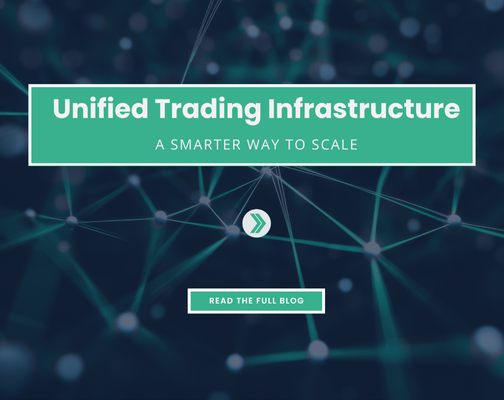The True Cost of Real-Time Market Data Infrastructure: Part I Summary
For capital markets firms, the decision to build or buy real-time market data infrastructure carries significant cost, time, and risk implications.
To aid firms in visualizing the investment necessary to develop this infrastructure, we composed a two-part series of white papers, The True Cost of Real-Time Market Data Infrastructure: Quantifying the Build vs. Buy Debate for Capital Markets Firms. Part I provides a detailed analysis of the costs and resources involved in building and maintaining real-time market data infrastructure in-house versus buying from specialized vendors, such as Exegy.
The first paper in the series, Part I: A Cost and Resource Analysis on Building and Maintaining Market Data Processing Technology in Software, illustrates why building in-house market data infrastructure is significantly more expensive, time-consuming, and operationally burdensome than vendor-managed solutions.
Key findings from Part I of the report reveal that in-house solutions are:
- 8 times more expensive to build: Building full North American coverage in-house costs $4.74 million versus $600,000 with vendor-managed solutions.
- 7 times slower to achieve market coverage: Market data vendors, such as Exegy, deliver production-ready solutions in 4-6 months, compared to 3.5 years for in-house teams.
- 2.6 times more costly to maintain: Annual in-house maintenance costs exceed $3.5 million, while a vendor-managed solution can be maintained at an annual cost of $1.47 million.
The analysis combines real-world benchmarks from a Tier 1 global bank with Exegy’s 20+ years of market data expertise. While Part I of the white paper focuses on software feed handlers, Part II (The Cost to Build and Maintain Market Data Processing Infrastructure Using FPGA Technology) will cover field-programmable gate array (FPGA)-based options for firms with ultralow-latency requirements.
Industry Challenges Driving Market Data Infrastructure Decisions
Before breaking down the challenges and comprehensive costs associated with building in-house, we must first outline the trends that are driving today’s firms to reassess their market data infrastructure.
Several key factors are placing unprecedented demands on existing systems:
- Constant exchange-directed changes (EDCs): Thousands of exchange notifications are delivered each year, with approximately 35% requiring code updates that average 140 hours each, creating a constant drain on engineering resources and diverting talent from strategic projects.
- Rising market data volumes: The rapid growth in trading activity and data generation is outpacing infrastructure upgrades, increasing the risk of outages and system failures.
- Constrained budgets and colocation space: Firms face budgetary pressures and limited physical space for data center expansion, making it difficult to scale traditional infrastructures cost-effectively.
- Heightening competition and tightening spreads: Increased market competition is driving tighter spreads, reducing fill rates, and forcing firms to optimize latency and data processing capabilities to maintain an edge.
As firms look for strategic solutions to the above industry macro trends, those opting to develop in-house will face a range of operational, financial, and strategic hurdles, including:
- Operational complexity
- Inefficient resource allocation
- Increased risk exposure
- Scalability challenges
Benefits of Vendor-Managed Solutions for Market Data Processing Infrastructure
Historically, many firms have built custom software-based market data processing systems to meet their trading and risk management needs. Although building market data feed handlers in-house may initially seem like a way to retain control, the true cost in time, resources, and ongoing maintenance is substantial.
Part I of the white paper series illustrates the comparative advantages of opting for a vendor-managed solution, including:
Lower Initial Cost to Build
Building market data processing infrastructure from the ground up is a complex and resource-intensive endeavor, and it starts with the first foundational market feed handler. Although subsequent feed handlers can leverage the frameworks and templates established during the initial build, the initial feed handler represents the most substantial engineering investment.
Building the first in-house software feed handler costs $1.85 million, and full North American coverage (20 markets) exceeds $4.7 million. Compared to the $600,000 cost of a vendor-managed solution, such as Exegy’s, in-house builds are eight times more expensive for full North American equities coverage.
And the cost goes far beyond direct building expenses. The development effort Exegy calculated accounts for not only the core engineering work required to build each component but also factors in the time spent on testing, quality assurance (QA), project management, and documentation.
Total software development effort alone for building the initial handler equates to more than 55 person-months of combined engineering effort. Meanwhile, Exegy delivers full market coverage in as little as four months, significantly reducing lost revenue opportunities resulting from delayed deployments.
Efficient Scalability
Once the first in-house software feed handler is complete, building additional handlers becomes faster, but it still proves costly and resource-intensive. Each new market requires:
- Business requirements gathering
- Development of exchange-specific protocol logic
- QA and testing cycles
Unique exchange requirements and the need for efficient scaling still demand significant engineering resources. For example, the calculated cost to build an additional feed handler in-house is $152,250. An additional 19 feed handlers are necessary for full North American market coverage, which brings that total to $2.89 million and necessitates more than nine years of total engineering effort.
More than 90% of that cost comes from development and QA efforts, reflecting the technical complexity of market data feed handlers. Not to mention, firms must consider how diverting this level of effort from other strategic initiatives impacts overall business agility and innovation.
Vendor-managed solutions eliminate these per-market scaling costs, enabling firms to expand into new asset classes and geographies without a proportional rise in time or resources. By comparison, Exegy provides additional market coverage for about $30,000 per market and includes it as part of a full rollout that delivers 20 markets in just 4-6 months.
Reduced Maintenance Costs
Lastly, maintaining real-time market data infrastructure—particularly in the face of constant EDCs—is yet another complex and resource-intensive task, involving continuous updates and proactive support to ensure system reliability. Maintaining the underlying market data infrastructure requires consistent engineering effort for:
- System enhancements
- Bug fixes
- Performance optimizations
- Rapid incident resolution
As more feed handlers are added, incremental resources become necessary to maintain optimal system performance. The total yearly cost for maintaining 1-15 markets is around $3.5 million, according to both Exegy and the Tier 1 bank’s estimates. This figure includes:
- EDC management team costs
- System maintenance team costs
- 24/7 monitoring and support team costs
Note that much of this cost is tied to managing EDCs, with hundreds of notifications per year and many requiring significant development and QA time. With Exegy’s managed solution, firms are looking at about a 2.6 times reduction in maintenance costs, with the benefits of EDC compliance, proactive monitoring, and ongoing updates as part of the service, resulting in savings of more than $3.5 million annually.
Strategic Takeaways
Outsourcing market data processing to a vendor, such as Exegy, provides cost savings, faster time to market, reduced operational overhead, and optimizes internal resources for core business innovations. According to our findings, opting for an in-house build rather than a vendor-managed solution is:
- 8 times more expensive to build
- 7 times slower going to market
- 2.6 times more costly to maintain
Partnering with Exegy provides a faster, more cost-effective, and lower-risk path to achieving market data infrastructure goals—empowering firms to innovate, scale, and compete more effectively. For a detailed look at our calculations and methodology, download the full white paper, Part I: A Cost and Resource Analysis on Building and Maintaining Market Data Processing Technology in Software.
While Part I pertains to traditional, software-based market data processing, Part II of this series will cover the cost to build and maintain FPGA-based feed handlers for firms with ultra-low latency requirements.



